| Regular Icosahedron | |
|---|---|
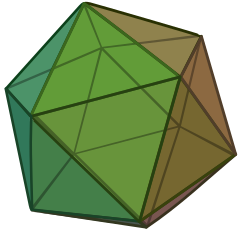 (Click here for rotating model) | |
| Type | Platonic solid |
| Elements | F = 20, E = 30 V = 12 (χ = 2) |
| Faces by sides | 20{3} |
| Schläfli symbol | {3,5} |
| Wythoff symbol | 5 | 2 3 |
| Coxeter-Dynkin | |
| Symmetry | Ih (*532) |
| References | U22, C25, W4 |
| Properties | Regular convex deltahedron |
| Dihedral angle | 138.189685° = arccos(-√5/3) |
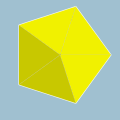 3.3.3.3.3 (Vertex figure) |
 Dodecahedron (dual polyhedron) |
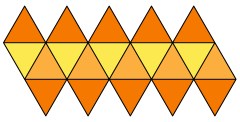 Net | |
In geometry, an icosahedron (Greek: eikosaedron, from eikosi twenty + hedron seat; /ˌaɪ.kəʊ.sə.ˈhi.dɹən/; plural: -drons, -dra /-dɹə/) is any polyhedron having 20 faces, but usually a regular icosahedron is implied, which has equilateral triangles as faces.
The regular icosahedron is one of the five Platonic solids. It is a convex regular polyhedron composed of twenty triangular faces, with five meeting at each of the twelve vertices. It has 30 edges and 12 vertices. Its dual polyhedron is the dodecahedron.
Dimensions[]
If the edge length of a regular icosahedron is , the radius of a circumscribed sphere (one that touches the icosahedron at all vertices) is
and the radius of an inscribed sphere (tangent to each of the icosahedron's faces) is
while the midradius, which touches the middle of each edge, is
where (also called ) is the golden ratio.
Area and volume[]
The surface area and the volume of a regular icosahedron of edge length are:
Cartesian coordinates[]
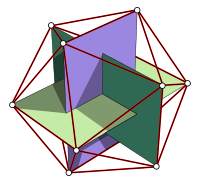
The following Cartesian coordinates define the vertices of an icosahedron with edge-length 2, centered at the origin:
where is the golden ratio (also written τ). Note that these vertices form five sets of three mutually centered, mutually orthogonal golden rectangles.
The 12 edges of a regular octahedron can be partitioned in the golden ratio so that the resulting vertices define a regular icosahedron. This is done by first placing vectors along the octahedron's edges such that each face is bounded by a cycle, then similarly partitioning each edge into the golden mean along the direction of its vector. The five octahedra defining any given icosahedron form a regular polyhedral compound, as do the two icosahedra that can be defined in this way from any given octahedron.
Construction by a system of equiangular lines[]
The following construction of the icoshaedron avoids tedious computations in the number field necessary in more elementary approaches.
Existence of the icosahedron amounts to the existence of six equiangular lines in . Indeed, intersecting such a system of equiangular lines with an Euclidean sphere centered at their common intersection yields the twelve vertices of a regular icosahedron as can easily be checked. Conversely, supposing the existence of a regular icosahedron, lines defined by its six pairs of opposite vertices form an equiangular system.
In order to construct such an equiangular system, we start with the matrix
of square size . (Mnemonic: the matrix encodes the angles, acute for a positive entry, obtuse otherwise, between five cyclically consecutive vertices adjacent to a first vertex of an icosahedron centered at the origin.)
A straightforward computation yields . This implies that has eigenvalues , both with multiplicity 3 since is symmetric and of trace 0. The matrix induces thus an Euclidean structure on the quotient space which is isomorphic to since the kernel of has dimension 3. The image under the projection of the six coordinate axes in forms thus a system of six equiangular lines in intersecting pairwise at a common acute angle of . Orthogonal projection of onto the -eigenspace of yields thus the twelve vertices of the icosahedron.
A second straightforward construction of the icosahedron uses representation theory of the alternating group acting by direct isometries on the icosahedron.
Stellations[]
According to specific rules defined in the book The fifty nine icosahedra, 59 stellations were identified for the regular icosahedron. The first form is the icosahedron itself. One is a regular Kepler-Poinsot solid. Three are regular compound polyhedra.[1]
 The faces of the icosahedron extended outwards as planes intersect, defining regions in space as shown by this stellation diagram of the intersections in a single plane. |

|

|

|

|

|

|
||

|

|

|

|

| ||||

|

|

|

|
Geometric relations[]
 Icosahedron as a snub tetrahedron. |
 Icosahedron as an alternated truncated octahedron. |
There are distortions of the icosahedron that, while no longer regular, are nevertheless vertex-uniform. These are invariant under the same rotations as the tetrahedron, and are somewhat analogous to the snub cube and snub dodecahedron, including some forms which are chiral and some with Th-symmetry, i.e. have different planes of symmetry from the tetrahedron. The icosahedron has a large number of stellations, including one of the Kepler-Poinsot polyhedra and some of the regular compounds, which could be discussed here.
The icosahedron is unique among the Platonic solids in possessing a dihedral angle not less than 120°. Its dihedral angle is approximately 138.19°. Thus, just as hexagons have angles not less than 120° and cannot be used as the faces of a convex regular polyhedron because such a construction would not meet the requirement that at least three faces meet at a vertex and leave a positive defect for folding in three dimensions, icosahedra cannot be used as the cells of a convex regular polychoron because, similarly, at least three cells must meet at an edge and leave a positive defect for folding in four dimensions (in general for a convex polytope in dimensions, at least three facets must meet at a peak and leave a positive defect for folding in n-space). However, when combined with suitable cells having smaller dihedral angles, icosahedra can be used as cells in semi-regular polychora (for example the snub 24-cell), just as hexagons can be used as faces in semi-regular polyhedra (for example the truncated icosahedron). Finally, non-convex polytopes do not carry the same strict requirements as convex polytopes, and icosahedra are indeed the cells of the icosahedral 120-cell, one of the ten non-convex regular polychora.
An icosahedron can also be called a gyroelongated pentagonal bipyramid. It can be decomposed into a gyroelongated pentagonal pyramid and a pentagonal pyramid or into a pentagonal antiprism and two equal pentagonal pyramids.
The icosahedron can also be called a snub tetrahedron, as snubification of a regular tetrahedron gives a regular icosahedron. Alternatively, using the nomenclature for snub polyhedra that refers to a snub cube as a snub cuboctahedron (cuboctahedron = rectified cube) and a snub dodecahedron as a snub icosidodecahedron (icosidodecahedron = rectified dodecahedron), one may call the icosahedron the snub octahedron (octahedron = rectified tetrahedron).
A rectified icosahedron forms an icosidodecahedron.
Icosahedron vs dodecahedron[]
When an icosahedron is inscribed in a sphere, it occupies less of the sphere's volume (60.54%) than a dodecahedron inscribed in the same sphere (66.49%).
Also, as these are duals, it is possible to transform one into the other(See below).
 Icosahedron |
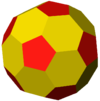 Truncated icosahedron |
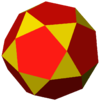 Icosidodecahedron |
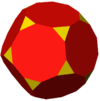 Truncated dodecahedron |
 Dodecahedron |
Uses and natural forms[]
|
Electron micrograph of Herpes simplex virus. |
Many viruses, e.g. herpes virus, have the shape of an icosahedron. Viral structures are built of repeated identical protein subunits and the icosahedron is the easiest shape to assemble using these subunits. A regular polyhedron is used because it can be built from a single basic unit protein used over and over again; this saves space in the viral genome. |
In 1904, Ernst Haeckel described a number of species of Radiolaria, including Circogonia icosahedra, whose skeleton is shaped like a regular icosahedron. A copy of Haeckel's illustration for this radiolarian appears in the article on regular polyhedra.
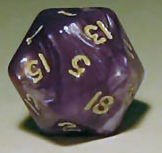 Twenty-sided die. |
In some roleplaying games, the twenty-sided die (for short, d20) is used in determining success or failure of an action. This die is in the form of a regular icosahedron. It may be numbered from "0" to "9" twice (in which form it usually serves as a ten-sided die, or d10), but most modern versions are labeled from "1" to "20". See d20 System. |
An icosahedron is the three-dimensional game board for Icosagame, formerly known as the Ico Crystal Game.
An icosahedron is used in the board game Scattergories to choose a letter of the alphabet. Six little-used letters, such as X, Q, and Z, are omitted.
Inside a Magic 8-Ball, various answers to yes-no questions are printed on a regular icosahedron.
The icosahedron displayed in a functional form is seen in the Sol de la Flor light shade. The rosette formed by the overlapping pieces show a resemblance to the Frangipani flower.
If each edge of an icosahedron is replaced by a one ohm resistor, the resistance between opposite vertices is 0.5 ohms, and that between adjacent vertices 11/30 ohms.[2]
The symmetry group of the icosahedron is isomorphic to the alternating group on five letters. This nonabelian simple group is the only nontrivial normal subgroup of the symmetric group on five letters. Since the Galois group of the general quintic equation is isomorphic to the symmetric group on five letters, and the fact that the icosahedral group is simple and nonabelian means that quintic equations need not have a solution in radicals. The proof of the Abel-Ruffini theorem uses this simple fact, and Felix Klein wrote a book that made use of the theory of icosahedral symmetries to derive an analytical solution to the general quintic equation.
See also[]
Template:Wiktionarypar
- Truncated icosahedron
- Regular polyhedron
- Geodesic grids use an iteratively bisected icosahedron to generate grids on a sphere
- Jessen's icosahedron
References[]
Template:Wikisource1911Enc
- ↑ Coxeter, Harold Scott MacDonald; Du Val, P.; Flather, H. T.; Petrie, J. F. (1999), The fifty-nine icosahedra (3rd ed.), Tarquin, ISBN 978-1-899618-32-3, Template:MathSciNet (1st Edn University of Toronto (1938))
- ↑ Klein, Douglas J. (2002). "Resistance-Distance Sum Rules" (PDF). Croatica Chemica Acta 75 (2): 633–649. http://public.carnet.hr/ccacaa/CCA-PDF/cca2002/v75-n2/CCA_75_2002_633_649_KLEIN.pdf. Retrieved 2006-09-15.
External links[]
Template:Commonscat
- Weisstein, Eric W., "Icosahedron" from MathWorld.
- Paper models of the icosahedron
- The Uniform Polyhedra
- K.J.M. MacLean, A Geometric Analysis of the Five Platonic Solids and Other Semi-Regular Polyhedra
- Interactive Icosahedron model - works right in your web browser
- Virtual Reality Polyhedra The Encyclopedia of Polyhedra
- Tulane.edu A discussion of viral structure and the icosahedron
- Paper Models of Polyhedra Many links
- Origami Polyhedra - Models made with Modular Origami
- video of icosahedral mirror sculpture
Template:Polyhedra
az:İkosaedr
ca:Icosàedre
cs:Dvacetistěn
da:Ikosaeder
et:Ikosaeeder
eo:Dudekedro
fa:بیستوجهی
it:Icosaedro
he:איקוסהדרון
lv:Ikosaedrs
hu:Ikozaéder
nl:Icosaëder
no:Ikosaeder
pl:Dwudziestościan foremny
pt:Icosaedro
simple:Icosahedron
sq:Ikosaedri i rregullt
sr:Икосаедар
sv:Ikosaeder
ta:இருபதுமுக முக்கோணகம்
th:ทรงยี่สิบหน้า
uk:Ікосаедр














![{\displaystyle \mathbb {Q} \left[{\sqrt {5}}\right]}](https://services.fandom.com/mathoid-facade/v1/media/math/render/svg/07522b82bfc9c88f8a9a6f7a2303e530f5eee4d7)

















